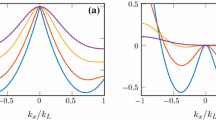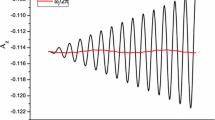Abstract
A 2-level condensate of spin-1 Na atoms under a magnetic field B with its spin modes decoupled from its spatial modes is studied. This system can emerge at very low temperature by putting an atom with its spin down into a fully polarized condensate with all \(N-1\) spins up, similar to embedding an impurity into a well-organized system. The most distinguished feature of this 2-level system is that it is inert to B in general, but extremely sensitive to B in a specific domain D-o-S around \(B_0\) at which the energy gap between the two levels arrives at a minimum. Population oscillations are found and the underlying regularity is clarified and described by simple formulae. Therefore, the inherent dynamic parameters of the condensate can be known via the measurement of the population. The experimental condition that such a system can exist has been evaluated. Furthermore, there is a characteristic constant \(\gamma =0.278466\) common to various 2-level systems. This constant provides a common upper bound \(\gamma k_{B}T\) for the internal energy U of all these systems.








Similar content being viewed by others
References
J. Stenger et al., Nature 396, 345 (1998)
Z.B. Li, D.X. Yao, C.G. Bao, J. Low Temp. Phys. 180, 200 (2015)
H. Jing, D.S. Goldbaum, L. Buchmann, P. Meystre, Phys. Rev. Lett. 106, 223601 (2011)
B. Pasquiou, E. Marechal, G. Bismut, P. Pedri, L. Vernac, O. Gorceix, B. Laburthe-Tolra, Phys. Rev. Lett. 106, 255303 (2011)
A. de Paz, A. Chotia, E. Marechal, P. Pedri, L. Vernac, O. Gorceix, and B. Laburthe-Tolra, arXiv:1212.5469
B. Pasquiou, E. Marechal, L. Vernac, O. Gorceix, B. Laburthe-Tolra, Phys. Rev. Lett. 108, 045307 (2012)
M.A. Nielsen, I.L. Chuang, Quantum Computation and Quantum Information (Cambridge University Press, Cambridge, 2000)
M. Abdel-Aty, Prog. Quantum Electron. 31, 1 (2007)
P.P. Orth, A. Imambekov, K. Le Hur, Phys. Rev. B 87, 014305 (2013)
J. Katriel, Mol. Struct. 547, 1 (2001)
C.G. Bao, Z.B. Li, Phys. Rev. A 70, 043620 (2004)
C.G. Bao, Z.B. Li, Phys. Rev. A 72, 043614 (2005)
C.G. Bao, J. Phys. A 45, 235002 (2012)
H.T. Quan, Z. Song, X.F. Liu, P. Zanardi, C.P. Sun, Phys. Rev. Lett. 96, 140604 (2006)
W.-L. You, Y.-W. Li, S.-J. Gu, Phys. Rev. E 76, 022101 (2007)
T.L. Ho, Phys. Rev. Lett. 81, 742 (1998)
C.K. Law, H. Pu, N.P. Bigelow, Phys. Rev. Lett. 81, 5257 (1998)
M.S. Chang, Q. Qin, W.X. Zhang, L. You, M.S. Chapman, Nat. Phys. 1, 111 (2005)
J. Kronjäger, C. Becker, M. Brinkmann, R. Walser, P. Navez, K. Bongs, K. Sengstock, Phys. Rev. A 72, 063619 (2005)
A.T. Black, E. Gomez, L.D. Turner, S. Jung, P.D. Lett, Phys. Rev. Lett. 99, 070403 (2007)
Y. Endo, T. Nikuni, J. Low Temp. Phys. 152, 21 (2008)
S.S. Natu, E.J. Mueller, Phys. Rev. A 81, 053617 (2010)
H.K. Pechkis, J.P. Wrubel, A. Schwettmann, P.F. Griffin, R. Barnett, E. Tiesinga, P.D. Lett, Phys. Rev. Lett. 111, 025301 (2013)
M. Luo, C.G. Bao, Z.B. Li, Phys. Rev. A 77, 043625 (2008)
Z.F. Chen, C.G. Bao, Z.B. Li, J. Phys. Soc. Jpn. 78, 114002 (2009)
W. Peng, Z.B. Li, C.G. Bao, J. Phys. B 40, 577 (2007)
Acknowledgments
The project was supported by the National Basic Research Program of China (2008AA03A314, 2012CB821400, 2013CB933601), NSFC Projects (11274393, 11074310, 11275279), RFDPHE of China (20110171110026), and NCET-11-0547.
Author information
Authors and Affiliations
Corresponding author
Appendix: The Energy \(E_{1}^{B,\mathrm{ex}}\) of the Lowest State with a Spatial Mode Excited
Appendix: The Energy \(E_{1}^{B,\mathrm{ex}}\) of the Lowest State with a Spatial Mode Excited
A well-known spatially excited mode is the excitation of the c.m. motion in harmonic isotropic trap with the excitation energy \(\hbar \omega \). However, it has been proved in [12, 26] that the lowest state with a spatial mode excited is not the one with collective c.m. excitation, but the one with only one particle spatially excited. This state has its spatial wave function belonging to the [\(N-1\),1] representation of the permutation group (accordingly, the total spin state belongs also to this representation to assure the bosonic statistics). Note that spatially anti-symmetric pairs are contained in the [\(N-1\),1] representation. Since the central interaction is repulsive, the appearance of the anti-symmetric pairs will reduce the repulsive energy. Therefore, the state belonging to the [\(N-1\),1] representation could be lower than the state with c.m.-excitation.
According to the Refs. [12, 26], when \(B=0\) and for an isotropic confinement, the lowest group of states with a spatial mode excited is \(\Psi _{\mathrm{ex},S}^{[N-1,1]}=\frac{1}{\sqrt{N}}\sum _{i}\varphi _{S}^{b}(i)\Pi _{j(\ne i)}\varphi _{S}^{a}(j)\Theta _{S,M}^{i}\), where \(\varphi _{S}^{b}\) and \( \varphi _{S}^{a}\) are spatial wave functions for the particles i and j, and with orbital angular momenta 1 and 0, respectively. \(\Theta _{S,M}^{i}\) is a total spin state with good quantum numbers S and M, belonging to the [\(N-1\),1] representation. The expression of \(\Theta _{S,M}^{i}\) is given in [12]. Obviously, \(\Psi _{ex,S}^{[N-1,1]}\) is totally symmetric, where \(\varphi _{S}^{b}\) and \(\varphi _{S}^{a}\) can be obtained by solving the equations given in [12].
When \(H_{B}\) is applied and M is conserved, the set \(\Psi _{\mathrm{ex},S}^{[N-1,1]}\) with different S will be mixed up. However, the permutation symmetry [\(N-1\),1] of the spin states cannot be changed because \( H_{B}\) is symmetric with respect to the interchange of spins. Besides, different spatial modes cannot be mixed up by \(H_{B}\) because it acts only at the spins. Therefore, the mixing is essentially taking place in the subspace spanned by \(\Psi _{\mathrm{ex},S}^{[N-1,1]}\) with S ranging from M to \( N-1\) (\(S=0\) and N are not allowed by symmetry constraint) [10]. When \(M=N-2\), only two basis functions, \(\Psi _{\mathrm{ex},N-2}^{[N-1,1]}\) and \(\Psi _{\mathrm{ex},N-1}^{[N-1,1]}\) are involved. When the Hamiltonian is diagonalized in this two-dimensional space, the eigenenergy \(E_{1}^{B,\mathrm{ex}}\) can be therefore obtained. By using the fractional parentage coefficients [12], the matrix elements needed for the calculation are as follows.
When both \(N-S^{\prime }\) and \(N-S\) are even,
where
When both \(N-S^{\prime }\) and \(N-S\) are odd,
where
When \(N-S^{\prime }\) is odd and \(N-S\) is even,
Rights and permissions
About this article
Cite this article
Li, Z.B., Yao, D.X., He, Y.Z. et al. A 2-Level Condensate with Tunable and Sharp Susceptibility Against the Magnetic Field. J Low Temp Phys 182, 13–27 (2016). https://doi.org/10.1007/s10909-015-1345-3
Received:
Accepted:
Published:
Issue Date:
DOI: https://doi.org/10.1007/s10909-015-1345-3




